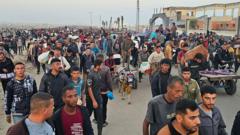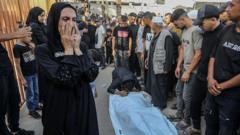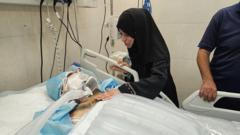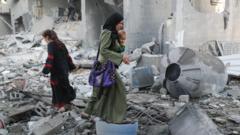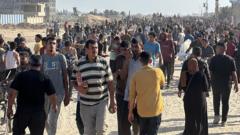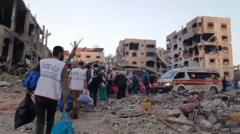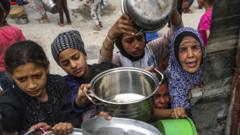As the World Food Programme (WFP) reported in a recent statement, chaotic scenes unfolded in Gaza as civilians clamored for aid trucks carrying vital food supplies. This occurrence arises from a dire humanitarian crisis, where food scarcity has left many families struggling to survive. The WFP successfully delivered 77 trucks filled with flour, yet as the hunger-stressed populace received word of the food's arrival, they rushed the incoming trucks, reflecting their desperation and need for sustenance.
Gaza Humanitarian Crisis: Chaos Amid Desperation for Aid

Gaza Humanitarian Crisis: Chaos Amid Desperation for Aid
Scenes of desperation erupted in Gaza as civilians rushed to claim food deliveries from World Food Programme trucks, highlighting an ongoing humanitarian crisis that has left many starving.
WFP officials noted that all trucks were forcibly halted en route, as hungry residents took matters into their own hands in a desperate attempt to feed their families. Abeer Etefa, a spokeswoman for the WFP, highlighted the challenging circumstances stating that, after nearly 80 days of a stringent blockade, starving individuals would not permit a food truck to pass unscathed. Despite a reduction in the blockade on May 19, the UN reported that aid deliveries amounted to only 10% of the daily requirements for the population.
While WFP has made efforts to deliver food more securely and directly to those in need, the chaos has proven difficult to manage. Recent assessments reveal that the entire population of Gaza is at critical risk of famine, with around two million people requiring immediate food assistance. The challenge lies not only in the supply of aid but also in its distribution amidst ongoing violence, as the UN humanitarian agency contends with insecurity and logistical limitations.
Adding to the complexity, tensions between Israel and Hamas persist, fueling further conflict in the region. In recent military operations, Israeli airstrikes reportedly resulted in numerous casualties in Gaza, stirring discontent and condemnation from various sectors including neighboring Arab nations, which expressed concern over perceived violations of humanitarian principles. Meanwhile, a newly formed US and Israel-backed organization has begun distributing aid through designated sites—though tensions remain high over claims of aid theft by Hamas.
Doctors and medical staff in Gaza continue to face dire conditions, struggling to care for a growing number of patients, often resorting to rationing care as resources dwindle. The chaos surrounding the aid distribution may symbolize the broader tragedy unfolding in Gaza, urging a unified and more substantial response to alleviate the suffering of its citizens.
With the international spotlight returning to the region, questions remain about how to navigate the intricate landscape of humanitarian needs while addressing the ongoing conflict.
While WFP has made efforts to deliver food more securely and directly to those in need, the chaos has proven difficult to manage. Recent assessments reveal that the entire population of Gaza is at critical risk of famine, with around two million people requiring immediate food assistance. The challenge lies not only in the supply of aid but also in its distribution amidst ongoing violence, as the UN humanitarian agency contends with insecurity and logistical limitations.
Adding to the complexity, tensions between Israel and Hamas persist, fueling further conflict in the region. In recent military operations, Israeli airstrikes reportedly resulted in numerous casualties in Gaza, stirring discontent and condemnation from various sectors including neighboring Arab nations, which expressed concern over perceived violations of humanitarian principles. Meanwhile, a newly formed US and Israel-backed organization has begun distributing aid through designated sites—though tensions remain high over claims of aid theft by Hamas.
Doctors and medical staff in Gaza continue to face dire conditions, struggling to care for a growing number of patients, often resorting to rationing care as resources dwindle. The chaos surrounding the aid distribution may symbolize the broader tragedy unfolding in Gaza, urging a unified and more substantial response to alleviate the suffering of its citizens.
With the international spotlight returning to the region, questions remain about how to navigate the intricate landscape of humanitarian needs while addressing the ongoing conflict.

